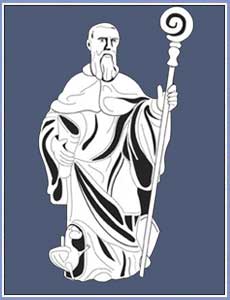

| The Benedictine motto "ora et
labora" (prayer and work) has played a part in the history
of St. Benedict Church from its very beginning. By "prayer
and work" the parishioners have shared much of themselves
with others. In participating in the mission of Jesus
Christ in our midst today, we continue to learn about,
practice and share our faith within our community.
St. Benedict was founded in 1885 as a place of worship for those who spoke German. As the parish grew there was a need for a larger church building. The cornerstone for the new church was laid on Sept. 22,1907. The church was designed by Samuel Hannaford & Sons. Over the next 80 years, there were additions made to the church. In 1927 a pipe organ was added & in 1986 it was renovated. In 1932 three church bells were installed in the tower. During the 1960's a renovation project included major changes in the sanctuary; a new altar, new lights, new pews, and window repairs. The school also has seen many changes. In 1922 plans were drawn up for a new, up-to-date building with ten large classrooms and auditorium. In addition to the eight grades of the grammar school, a business course of two years was introduced. In 1988 the school merged with Bishop Howard School and was named Holy Family School. Our parish's history has had ups and downs. The parish has dealt with floods, periods of growth and more recently a decline in parish membership. In the midst of these many changes, the Catholic faith has remained in Austinburg and Wallace Woods. The faithful continue "to pray and work" in the example of patron, St. Benedict. The future brings new opportunities not yet experienced in the parish's long and varied history. Your conscious participation in the mission of St. Benedict Church is vital to continuing the Catholic presence in this place called Austinburg and Wallace Woods. The Life of St. Benedict, our patron St. Benedict (ca. 480 - ca. 547) turned away from a comfortable life in Rome. Weary of a world full of strife and excess, he at first lived as a hermit in the mountains. Joined by early followers, St. Benedict established 12 communities of monk in Subiaco, Italy. His visionary model of community, charity, prayer, worship, work and stability reached fulfillment in his most famous monastery, Monte Cassino. St. Benedict's twin sister, St. Scholastica, shared a deep bond with her brother. She established or led a community of religious women in Plambariola, just a few miles from Monte Cassino. The Rule of St. Benedict has guided and influenced monastic life for centuries. Today more than 25,000 Benedictine men and women around the world follow the Rule of Benedict. His feast day is March 21 (on the Benedictine calendar) & July 11 (on the Roman calendar). |